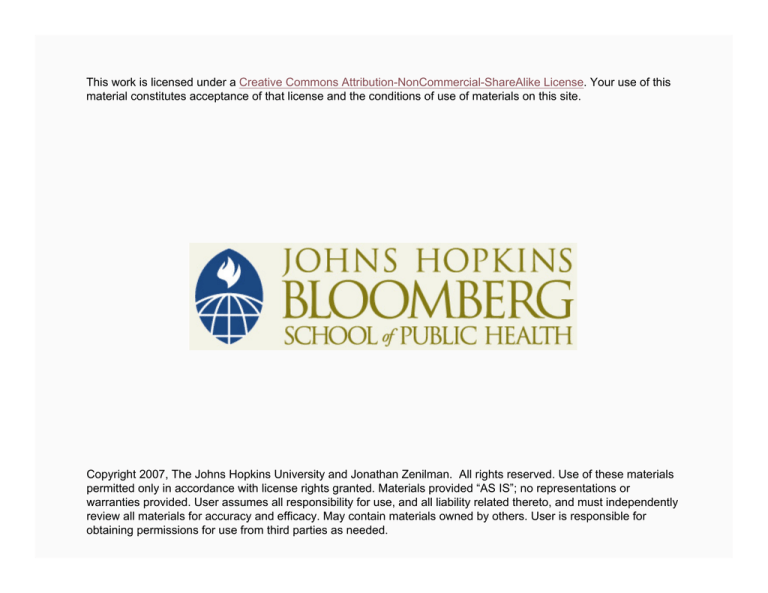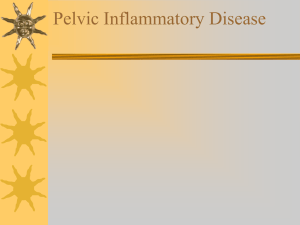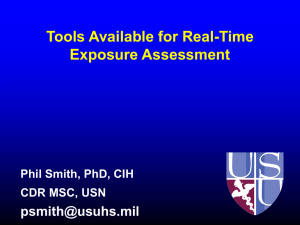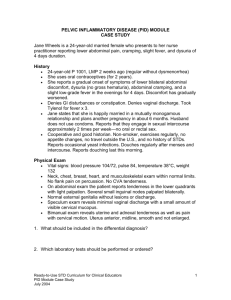
This work is licensed under a Creative Commons Attribution-NonCommercial-ShareAlike License. Your use of this
material constitutes acceptance of that license and the conditions of use of materials on this site.
Copyright 2007, The Johns Hopkins University and Jonathan Zenilman. All rights reserved. Use of these materials
permitted only in accordance with license rights granted. Materials provided “AS IS”; no representations or
warranties provided. User assumes all responsibility for use, and all liability related thereto, and must independently
review all materials for accuracy and efficacy. May contain materials owned by others. User is responsible for
obtaining permissions for use from third parties as needed.
Vaginitis and Pelvic Inflammatory Disease (PID)
Jonathan Zenilman, MD
Johns Hopkins University
Section A
Introduction to Vaginitis
Vaginitis
Most common reason for patient visit to OB/GYN resulting in 10
million patient visits per year
Three primary infections in order of prevalence:
− Bacterial vaginosis
− Candidiasis
− Trichomoniasis
4
Trichomonas
Parasitic
Relatively common
Cosmopolitan
Sexual intercourse
25% have been infected sometime
No congenital infections
Not generally spread by fomites
5
Pathogenesis (Trichomonas)
Desquamation of vaginal epithelium
− Leukocytic inflammation
− May persist for years
Symptomatology
− Women—itching, burning, frothy discharge worsens after
menses chronic
− Symptoms persist, however, parasite remains
− Men—mild urethritis (rare to carry in men due to
urine discharge)
Strawberry hemorrhage in 5% of infected women
− No discharge—pathogenesis is not well understood
6
Diagnosis
Diagnosis—wet mount sensitivity ~ 50%
InPOuch culture method—requires incubation and lab facilities
PCR—research based method, not clinically approved
Diagnosis in men—sensitivity of culture is poor
7
Trichomonas in Men
Necessary to treat male partners
Trich accounts for up to 10-15% of non-gonococcal urethritis
Reservoir in males—unclear
− Prostate?
8
Treatment
Metronidazole, 2 gm single dose
For resistant infection—only after confirmation—tinidazole
9
Trichomonas Vaginitis
Extremely common
Prevalent vs. incident infection
May facilitate HIV transmission
Associated with adverse pregnancy outcome
Metronidazole resistance in ~1%
10
Section B
Vulvovaginal Candidiasis
Vulvovaginal Candidiasis
13 million cases annually
85-90% C. albicans—in immunointact hosts
Commensal—pathogen
12
Vaginal Candidiasis
Inflammatory vaginitis
Prevalence/incidence high (30-50% of college students)
C. albicans part of normal flora
13
Treatment
Oral fluconazole (150 mg either as single or multiple dose)
Vaginal imidazoles—clotrimazole, miconazole, terconazole
Remove underlying causes if possible
No treatment of partners indicated
14
Current Issues
The biggest problem is that patients ascribe other infections to
“yeast infection”
Non-candida species
Fluconazole resistance (emerging issue, especially in
immunocompromised hosts)
15
Section C
Bacterial Vaginosis
Bacterial Vaginosis
Ecologic disturbance of vaginal flora
Not an STD
Dx based on clinical criteria or gram stain
17
Role of Vaginal Lactobacillus
Acidophillic lactobacilli—predominant organisms in normal vaginal
flora
Produce lactic acid and peroxide
− Results in acidic pH (3.6–4.2)
− Inhibits growth of G. vaginalis and anaerobes
Lactobacilli found in 96% of women with normal vaginal flora vs.
only 35% of women with BV
18
Vaginal pH
Normal vaginal pH(3.8–4.2) controls composition of normal vaginal
flora
Normal vaginal pH creates an unfavorable environment for BV
pathogens
Elevated vaginal pH is associated with the following:
− Loss of H2O2 producing lactobacilli
− Bacterial vaginosis, trichomoniasis
− May enhance HIV transmission
19
Primary Pathogens in BV
Anaerobes
Bacteroides sp (prevotella)
Peptostreptococcus sp
Eubacterium sp
Mobiluncus sp
Facultative Anaerobes
Gardnerella vaginalis
Mycoplasma hominis
20
Microbial Shifts Occurring in BV
BV is characterized by 100–1,000 fold increase in pathogenic bacteria
Lactobacilli concentrations decrease substantially
1011
G. Vaginalis
Anaerobes
Mycoplasmas
Lactobacillis
104
21
BV Pathogenesis Issues
Traditional microbial model does not fit clinical observations
Early studies in 1960s suggest transmissibility
Multiple studies demonstrate transmissibility in lesbians
Recurrence common
Ecologic vs. infectious?
22
New Technology
Diagnostic technology based on 16S ribosome RNA detection
Transformed bacteriology
Links clinical bacteriology to genetics
Infections due to fastidious and non cultivable organisms
23
Findings in BV
Seminal work done by Marrazzo (University of Washington); Martin
(LSU)
BV highly diverse
Finding of Atopium and Clostridial species
Finding of new BV-associated organisms
24
Conclusions
There may be an infectious agent in BV
Implications for prevention, treatment, and control
Probably a combination of pathogen and ecology
25
Factors Affecting Normal Vaginal Flora
Douching
Antibiotic therapy
Hormonal changes
Use of oral contraceptives
Foreign bodies (tampons, diaphragms, IUD)
Semen
Menses
26
Clinical Diagnosis of BV (Amsel Criteria—Three of Four
Required)
Clinical Criteria
Sensitivity
Specificity
Wet Mount
High
High
Whiff Test
Moderate
Moderate
pH Test
High
Low
Homog Discharge
Low
Low
27
Gram Stain Criteria for BV (Spiegel Method)
Few lactobacilli
Large quantity of Gardnerella morphotypes
Abundant small Gram (–) bacilli and Gram (+) cocci
Curved gram variable bacilli (may be scored from
0–10, based on #1, 2, 4)
28
Syndromes
Sporadic
Primary
Secondary (antibiotic, pregnancy)
Recurrent
Primary
Secondary (DM, hormones, immunosuppression)
29
Gynecologic Complications of BV
Pelvic Inflammatory Disease (PID)
Post-abortal PID
Post-surgical infection
Cervical intraepithelial neoplasia
Mucopurulent cervicitis
30
Obstetric Complications of BV
Pre-term birth
PROM
Amniotic fluid infection
Chorioamnionitis
Postpartum endometritis
31
BV and Endometritis
Presence of BV or anaerobies from endomeotrial biopsies was
associated with increased risk for acute plasma cell endometritis
Source: Haggerty (2004), JID; 39: 990-5
32
VIPS: Vaginal Infections and Prematurity Study
10,397 pregnant women followed prospectively
Multi-center
Pre-term delivery associated with the following:
− Minority status
− Previous LBW infant
− Abortions/stillbirth
− Smoking
− UTI in pregnancy
− Antibiotic use prior to enrollment
Source: NEMJ (1995); 333: 1737-42
33
VIPS Summary
BV increases the risk of LBW and PMR
BV and prematurity are more frequent in black women and are
associated
Treatment with metronidazole/erythromycin reduces the increased
risk by approximately 2/3
34
Bacterial Vaginosis and HIV
1,196 HIV seronegative women followed antenatally and postnatally
BV was associated with antenatal and postnatal HIV acquisition
23% attributable risk ascribed to BV, with risk graded to disturbance
in vaginal flora
Confirmed in Uganda-Rakai study
Source: Taha, et al. (1998). AIDS 12: 1699-1706
35
Male Partner Effects?
No male partner factor identified
BV more common in sexually active women
Partner treatment not indicated
36
Treatment of BV: CDC Recommendations
Metronidazole—500 mg BID x 7 days
Metronidazole—2 g x 1 dose
Clindamycin—300 mg BID x 7 days
Metronidazole—0.75% vaginal gel 5 g BID x 5 days
Clindamycin—2.0% vaginal cream 5 g QHS x 7 days
37
Public Health Dilemmas and BV
Very high prevalence and recurrence in some areas
− Impact on syndromic STD management
Is BV risk related to risk factors or endogenous factors?
Impact of microbicides on BV-risk-collateral effects?
38
Differential Diagnosis of Vaginal Infections
39
Section D
Pelvic Inflammatory Disease (PID): The Basics
PID
Inflammation of upper genital
tract
“Catch all” Term—may include
endometritis, salpingitis, tuboovarian abscess (TOA), and pelvic
peritonitis
41
Who Cares?
Most important complication of STIs
~ 1 million women affected yearly in U.S.
Of those, 10%-25% are hospitalized
> 25% women suffer long-term sequelae
Expensive to manage [10.2 billion $/yr]
42
Pathogenesis of PID
Theory 1 GC/CT infections cause
tissue damage leading to
superinfection w/ vaginal and
cervical aerobes and anaerobes
Limitation—GC and CT are
isolated in < 50% of cases of PID
Theory 2 polymicrobial infection
from the outset— i.e., not
necessarily associated w/ GC and
CT infections
Limitation—why does the
polymicrobial infection happen?
43
PID Pathogenesis
Lower Tract Infection
Inflammation
Alterations in pH
Breakdown of Defense Mechanisms
Ascent of Organisms
Upper Tract Infection
Immunological Response
Inflammation, Scarring
44
Mechanisms of Ascent
Cervix (ectopy)
Uterine contractions
Menstruation
Spermatozoa (“hitch-hikers”)
45
PID: Etiological Agents
Sexually Transmitted
C. Trachomatis
N. Gonorrhoeae
Mycoplasma spp
Unreaplasma urealyticum
In up to 30% of
cases, no organisms
identified
Endogenous
Group B steptococci
Enterobacteriaceae
Gardnerella
Anaerobes
Lactobacilli
Actinomyces
Veilonella
Anaerobic streptococci
Bacteroides
46
Risk Factors
Previous PID [recurrent disease in 25%]
GC/CT infections
BV [three-fold increased risk]
Multiple sex partners [not lifetime number]
Young age [70% < 25 years; 33% < 19 years]
IUD [two-fold increased risk; actinomyces]
Smoking
Menses [60% develop symptoms at the end of menses]
Douching
47
Symptoms
Lower abdominal pain
Fever
Abnormal discharge
48
PID Diagnosis
Laparoscopy—gold standard BUT
(i) invasive (ii) may miss mild
fallopian tube disease (iii) does
not detect endometritis (iv)
expensive
Endometrial biopsy—may miss
other involved areas [sens 39%89%; spec 67-89% when compared
to laparoscopy]
Clinical signs and symptoms
(more on that soon)
Important diagnostic
issue
Laparoscopic Views
49
PID Treatment
Broad spectrum antibiotics effective against GC, CT, and anaerobic
bacteria are recommended
− Do we use oral or intravenous antibiotics?
Outpatient oral therapy in > 75% of cases
− Who gets hospitalized?
Make sure you can follow-up outpatients in 24 hours
For mild to moderate disease, the PEACH study demonstrated the
equivalence of oral and parenteral antibiotic regimens
50
PID: Hospitalization of Women 15-44 Years-of-Age
Source: National Hospital Discharge Survey (National Center for Health Statistics, CDC)
51
PID Sequelae
Tubal Factor Infertility (TFI)
Ectopic pregnancy
Chronic pelvic pain
52
PID Sequelae: TFI
Number of
Episodes of PID
N
Infertility
None
0/493
0%
1
79/991
8.0%
2/312
28/45
49/229
0.6%
6.2%
21.4%
2
36/185
19.5%
3
26/65
40.0%
Mild
Moderate
Severe
Source: Westrom, et al. (1992), Sex Transm Dis; 19: 185-192
53
PID Sequelae: Ectopic Pregnancy, Chronic Pelvic Pain
9.1% of women who have had at
least one episode of
laparoscopically-documented PID
have had an ectopic pregnancy as
their first pregnancy following
their PID episode
− Westrom, et al. (1992) Sex
Transm Dis;19: 185-192
Up to 33% of women have been
reported to develop chronic pelvic
pain following an episode of PID
− Ness, et al. (2002) Am J Obstet
Gynecol; 186: 929-937
54
PID in HIV+ Women
Symptoms may not be severe
More likely to have TOA, persistent fever
Lower WBC counts
Treatment regimens are the same (few prospective studies)
55
Section E
Scratching the Surface: Diagnosis
Diagnostic Issue
How good are we at diagnosing PID clinically?
− In other words, do clinical signs and symptoms predict the
presence of PID?
57
PID Evaluation and Clinical Health (PEACH) Study
Multicenter randomized clinical trial; 3/96–2/99; 831 women aged
14–37 years; recruited from ER, ObGyn clinics, and STD clinics
Inclusion: (i) pelvic pain, (ii) bimanual tenderness, (iii) leukorrhea
or MPC and/or positive GC or CT test
Compare oral vs. IV antibiotics for treatment of PID
The study used clinical S&S for diagnosing PID
An endometrial biopsy was done on all women [note, < 50% of
women who were ultimately enrolled were found to have
endometritis]
58
How Did This Diagnostic Issue Come Up?
Up to 75% of women with post-infection tubal infertility have no prior
history of being diagnosed or treated for PID *
Up to 25% of women with symptoms suggestive of PID are diagnosed with
another condition altogether **
Source: * Fertil Steril (1982); 38: 553; ** Am J Obstet Gynecol (1969); 105: 1088
59
A Short but Important Aside . . .
Where are most of the data coming from?
A total of six studies have evaluated signs and symptoms and used
laparoscopy as the gold standard for diagnosing PID
Author (yr)
Jacobson (1969)
Lehtinen (1986)
Wasserheit (1986)
Paavonen (1989)
Morcos (1993)
Cibula (2001)
N (n+/n-)
716 (532/184)
35 (26/9)
36 (22/14)
41 (31/10)
176 (134/42)
141 (43/98)
Population
ObGyn
ObGyn
ObGyn/STD/ER
ObGyn
ObGyn
ObGyn
For a study to be adequately powered (80%) at a minimal detectable
difference of 5% between those with and those without PID, the
following sample sizes are needed for the different sensitivities: sens
70% (N=646), sens 80% (N=492), sens 90% (276)
Source: STI (2003); 79: 491–494
60
Minimal CDC Criteria for PID Diagnosis (until 2002)
Must Have All Three
Lower Abdominal
Tenderness
Adnexal
Tenderness
Cervical Motion
Tenderness
61
Additional Criteria for PID Diagnosis
Routine
Oral temp > 38.3 C
Abnormal discharge
Elevated ESR
Elevated C-reactive protein
Lab documented GC or CT
Elaborate
Histologic evidence of
endometritis
Radiologic evidence on
transvaginal sonogram
Laparoscopic abnormalities
62
Diagnosis of PID
Discriminant Analysis—Three variables influenced the prediction of the presence of PID: ESR, fever, and
adnexal tenderness
These variables correctly classified 65% of pts with laparoscopically-confirmed PID
Source: Sex Transm Infect (2003); 79: 491–494
63
Diagnosing PID
Low threshold
2006 CDC Guidelines
− Empiric treatment for PID should be initiated if one of the
following minimal criteria is present and there is no other cause
for the illness:
− Uterine/adnexal tenderness OR cervical motion tenderness
64
Pelvic Inflammatory Disease
Microbiological Issues
Representative of lower tract culture
Does the presence (absence) of GC or CT at the cervix imply its
presence (absence) in the UGT?
65
Section F
Scratching the Surface: Sequelae and Risk Factors
Issues with Sequelae: Tubal Factor Infertility
Scandinavian cohort of 2,501 women recruited from 1960 to 1984
who underwent laparoscopy because of symptoms suggestive of PID
1844 had lap-proven PID (“cases”) and 657 did not (“controls”)
− Note—87% of controls had evidence of an infection of the lower
genital tract
The groups were followed for 13,400 and 3,958 person-years,
respectively
75% of subjects in both groups attempted to conceive during the
follow-up period
TFI—infertility caused by tubal occlusion verified by HSG,
laparoscopy, laparotomy, or a combination
Source: Westrom, et al. (1992), Sex Transm Dis; 19: 185-192
67
Pelvic Inflammatory Disease and Fertility
Percentage and Number of Patients Attempting to Conceive Who Had Tubal
Factor Infertility by Age, Number of PID Episodes, and Severity of PID*
Age (Years)
< 25
• 25
Total
Number of
%
(n/N)
%
(n/N)
%
(n/N)
Episodes of PID
One
7.7
(59/771)
9.1
(20/220)
8.0
(79/991)
Mild
0.8
(2/241)
0.0
(0/71)
0.6
(2/312)
Moderate
6.4
(23/361)
5.6
(5/89)
6.2
(28/452)
Severe
20.1
(34/169)
25.0
(15/60)
21.4
(49/229)
Two
18.4
(29/158)
25.9
(7/27)
19.5
(36/185)
Three or More
37.7
(23/61)
75.0
(3/4)
40.0
(26/65)
Total
11.2 (111/990)
12.0
(30/251)
11.4
(141/1241)
PID = Pelvic Inflammatory Disease; n = total number of cases followed; N = total
number of evaluable cases
* Excluding those with non-tubal factor infertility and with incomplete infertility
examinations
Source: Westrom, et al. (1992), Sex Transm Dis; 19: 185-192
68
Peach Study
Risk of Reproductive Outcomes after Endometritis or UGTI* or No Endometritis /
No UGTI among with Clinical PID
No Endometritis / Endometritis, UGTI,
No UGTI (n = 258)
or Both (n = 356)
Crude OR Adjusted OR
(95% CI)
(95% CI)
Pregnant
103
40.2
142
40.8
1.0 (0.7–1.4) 0.8 (0.6–1.2)
Infertile
43
17.8
53
16.4
0.9 (0.6–1.4) 1.0 (0.6–1.6)
Recurrent PID
50
19.5
46
13.2
0.6 (0.4–1.0) 0.6 (0.4–0.9)
CPP
112
44.4
98
29.5
0.5 (0.4–0.7) 0.6 (0.4–0.9)
* UGTI was defined as isolation of gonorrhea and / or Chlamydia from the endometrium.
**Adjusted for age, PID history, race, and education. Pregnancy and infertility are
additionally adjusted for reported baseline infertility (one year of unprotected intercourse
without resulting pregnancy).
Outcome
No.
%
No.
%
Infertility—Defined by “lack of conception despite sexual activity with
“rare” or “never” use of contraception during 12 or more months of F/U”
Ectopic Pregnancy—A total of five women ONLY had an ectopic pregnancy
in follow-up
Source: Am J Obstet Gynecol (2003); 188: 141-8
69
Issues with Risk Factors: Douching
100 consecutive symptomatic women with PID confirmed by laparoscopy or
endometrial biopsy were compared with 119 symptomatic women with no
evidence of PID on either laparoscopy or endometrial biopsy (internal
controls) AND 762 randomly selected women without PID presenting to the
STD clinic for care (external controls)
Source: JAMA (1990); 263: 1936
70
Results
Adjusted Odds of PID
Douching compared to
no douching
Internal Controls
OR (95%CI)
1.9 (1.02-3.48)
External Controls
OR (95%CI)
1.7 (1.04-2.82)
Adjusted for age, race, parity, years of education, smoking, age at
first intercourse, frequency of intercourse, history of GC, CT, or
PID, contraception
71
Issues with Risk Factors: Contraception
Positive association between intrauterine devices and PID
− Is it causative?
Negative association between PID and oral contraceptive pill (OCP)
use
− Are OCPs protective?
72
PID and Hormonal Contraception
Contraceptive use by women [presenting for care at an STD clinic, an ObGyn
clinic, or the ED] with signs and symptoms of PID [confirmed by either
laparoscopy or endometrial biopsy] (cases) were compared to contraceptive
use by women [presenting for care at an STD clinic] who did not have clinical
signs of PID (controls)
Source: JAMA (1990); 263:54
73
Results
Unadjusted OR (95%CI) OR (95% CI) OR (95% CI)
OR
Overall
For CT
For GC
OC users
vs. nonusers
0.51
(0.340.90)
0.22
0.92
(0.08-0.64) (0.31-2.63)
Sample size too small
to adjust.
Adjusted
OR
OR (95%CI)
Overall
OR (95%
CI)
For CT
OR (95%
CI)
For GC
OC users
vs. nonusers
0.57
(0.311.04)
_
_
The authors however
added one variable at
a time and found no
appreciable change as
compared to
unadjusted Ors . . .
74
PID and Hormonal Contraception
Nested case control study in the PEACH cohort—326 controls, 133 endometritis
without UGTI cases, and 104 UGTI cases
Source: Am J Obstet Gynecol (2001); 185:121.
75
To Make Matters Slightly More Interesting:
Source: Am J Obstet Gynecol (2001); 185: 380–85
76
Pelvic Inflammatory Disease (PID): Summary
Strongly associated with infertility, ectopic pregnancy, and chronic
pelvic pain in women
Expensive
Effective antibiotic treatment is available
Problems remain with diagnostics and outcome measures
77










